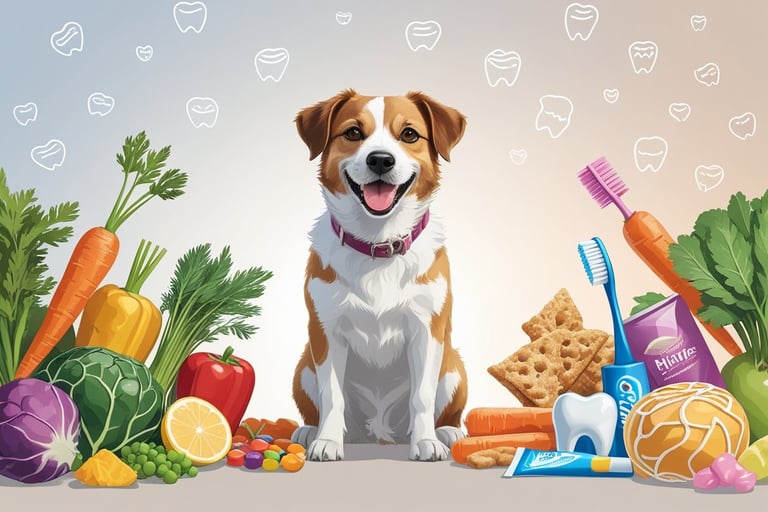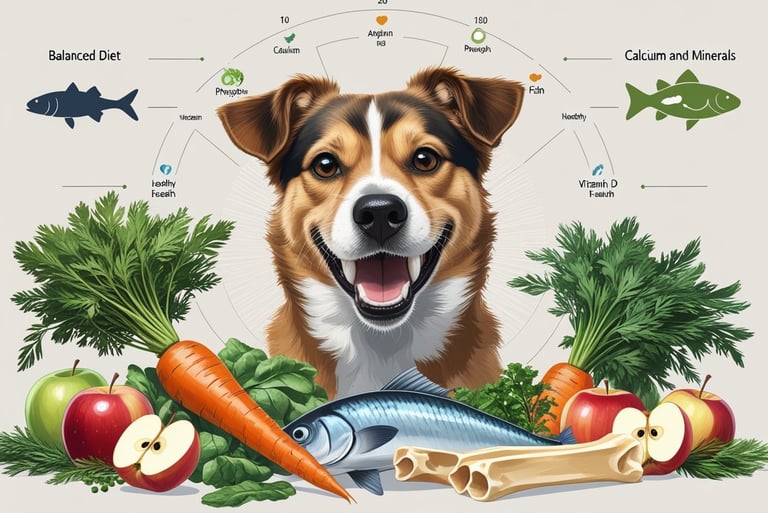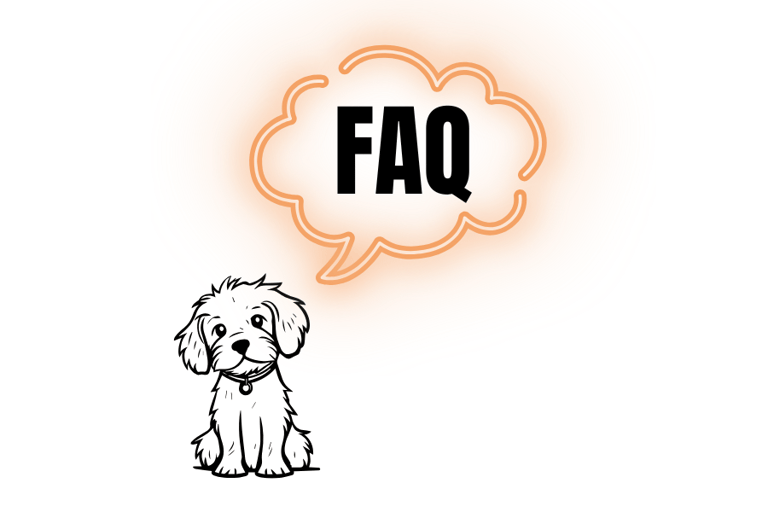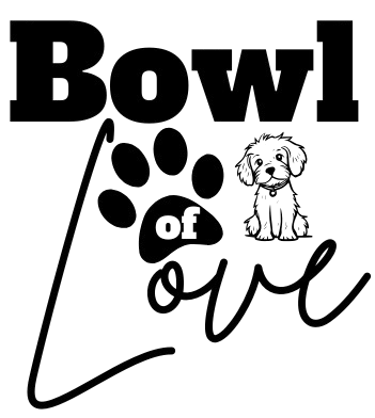Dental Health and Diet
Essential Food Tips to Keep Your Dog's Teeth Strong and Clean
DOG NUTRITION TIPS
10/4/202512 min read
Dental Health and Diet: Essential Food Tips to Keep Your Dog's Teeth Strong and Clean
At Bowl of Love, we sometimes recommend trusted products. If you choose to purchase through our links, we may earn a small commission at no additional cost to you. Thank you for supporting our mission to bring healthier food choices to dogs everywhere.
Most dog owners focus on their pet's overall nutrition but often overlook how food choices directly affect their furry friend's teeth and gums. What a dog eats has a significant impact on their dental health, with certain foods promoting strong teeth while others contribute to plaque buildup and gum disease. Over 80 percent of dogs show signs of oral disease by age three, making dietary choices more important than many pet parents realize.
Understanding which foods support dental health and which ones cause problems can help dog owners make better feeding decisions for their pets. The texture, ingredients, and nutritional content of dog food all play important roles in keeping teeth clean and gums healthy. Some foods naturally help scrub away plaque, while others stick to teeth and feed harmful bacteria.
This guide explores how different types of dog food affect oral health, what nutrients support strong teeth, and how chewing behaviors influence dental wellness. Dog owners will learn practical tips for choosing foods that promote good dental health and discover which dietary factors contribute to common dental problems in dogs.
The Link Between Diet and Dental Health in Dogs
What dogs eat directly impacts their mouth health through bacterial growth, nutrient absorption, and disease development. Food choices affect plaque buildup and gum health in ways that can prevent or worsen dental problems.
How Food Affects Oral Bacteria and Plaque
Food particles stick to dogs' teeth after eating. These bits feed harmful bacteria in the mouth.
Sugary and Starchy Foods Sugary and starchy foods create an inviting environment for dental issues by sticking to teeth surfaces. Sweet treats and high-carb kibble leave residue that bacteria love to eat.
When bacteria feed on these food particles, they produce acid. This acid attacks tooth enamel and irritates gums.
Plaque Formation Process
Bacteria multiply rapidly on food particles
They form sticky films called plaque
Plaque hardens into tartar within days
Wet food tends to stick more than dry food. However, some dry foods contain high amounts of sugar and starch that also cause problems.
The Role of Nutrients in Oral Tissue Integrity
Healthy gums and teeth need specific vitamins and minerals to stay strong. Nutrient-rich ingredients can prevent dental issues when included in a balanced diet.
Essential Nutrients for Dental Health
Calcium: Strengthens teeth and jaw bones. Can be found in raw bones and dairy.
Phosphorus: Works with calcium for bone health. Can be found in meat and fish. (These sardines from Amazon is our favorite.)
Vitamin C: Supports gum tissue. Can be found in vegetables.
Vitamin D: Helps calcium absorption. Can be found in fish and egg yolks. (If you're looking for salmon in water for your pet, these from Amazon are the best.)
Protein Quality Matters High-quality protein helps maintain healthy gum tissue. Poor protein sources can lead to weak gums that bleed easily.
Dogs eating fresh, whole foods typically have better oral health. Processed foods often lack these important nutrients or contain them in forms that are hard to absorb.
Understanding Periodontal Disease Risks
Periodontal disease affects the tissues around teeth, including gums and bone. Diet plays a major role in whether dogs develop this serious condition.
Stages of Periodontal Disease The disease starts with gingivitis from plaque buildup. Red, swollen gums are the first sign. Without treatment, it progresses to periodontitis.
In advanced stages, periodontal disease destroys the bone supporting teeth. Dogs can lose teeth and experience pain while eating.
Diet-Related Risk Factors
High-carb diets increase plaque formation
Sticky treats cling to teeth longer
Lack of chewing action from soft foods
More than 80 percent of dogs show signs of oral disease by age three. This high rate connects directly to modern commercial diets that promote bacterial growth.
Prevention Through Diet Raw meaty bones help scrape plaque off naturally. The chewing action massages gums and promotes blood flow. Avoiding sugary treats reduces bacterial food sources significantly.
Types of Dog Food and Their Effects on Teeth
Different types of dog food affect your dog's teeth in unique ways. Dry food can offer certain benefits for dental health, while wet food, raw diets, and special dental formulas each have their own impact on oral hygiene.
Dry Kibble Versus Wet Food: Pros and Cons
Dry kibble provides a scraping action when dogs chew. This helps remove some plaque buildup from tooth surfaces. The hard texture creates friction that can keep teeth cleaner than soft foods.
However, not all dry foods are equal. Low-quality kibble breaks apart too easily and doesn't provide much cleaning benefit. High-quality kibble with larger pieces requires more chewing. (If you're looking for a clean and raw kibble option for your pet, we highly recommend the Instinct Raw Boost dog food from Amazon. This dog food is what we personally use and our dogs love it.)
Wet food disadvantages include:
Sticks to teeth more easily
Provides no scraping action
Can increase plaque formation
Wet food does offer better hydration and easier digestion. Dogs with missing teeth or jaw problems may need wet food despite the dental drawbacks.
The key is choosing dry kibble designed for dental health rather than just any hard food.
Raw Diets and Natural Food Options
Raw diets can benefit dental health when they include appropriate bones and tough meat. Raw bones help scrape plaque and tartar naturally. Chewing raw meat exercises jaw muscles and gums.
Benefits of raw feeding:
Natural teeth cleaning through bone chewing
No processed sugars or starches
Stronger jaw muscles from increased chewing
Raw diets require careful planning to avoid nutritional gaps. Cooked bones should never be given as they can splinter and cause injury.
Some raw feeders notice cleaner teeth and fresher breath in their dogs. However, raw diets aren't suitable for all dogs or owners due to safety and convenience concerns.
Dietary Factors Contributing to Canine Dental Problems
Certain foods and feeding habits create conditions where harmful bacteria thrive in dogs' mouths. High-carb diets and sugary treats can lead to tartar and plaque buildup, while sticky foods cling to teeth and feed bacteria that cause dental disease.
Harmful Ingredients to Avoid
Sticky and sugary ingredients pose the biggest threat to canine dental health. Foods with corn syrup, molasses, or added sugars create an ideal environment for bacteria growth.
Wet foods with high moisture content tend to stick to teeth more than dry kibble. This creates a film that bacteria use as a breeding ground.
Artificial preservatives and fillers can also contribute to dental problems. These ingredients often lack the abrasive texture needed to naturally clean teeth during chewing.
Foods with high starch content break down into sugars in the mouth. Even grain-free foods with potatoes or peas can feed harmful bacteria when particles remain on teeth.
Low-quality proteins that don't require much chewing also miss opportunities for natural teeth cleaning. Dogs need foods that encourage proper chewing action.
Role of Sugar and Carbohydrates
A high-carb diet creates conditions for tartar and plaque development in dogs' mouths. Carbohydrates break down into simple sugars that feed bacteria.
Natural sugars from fruits and vegetables can be just as problematic as added sugars. Bacteria don't distinguish between sugar sources when creating acid that damages teeth.
The timing of carbohydrate consumption matters too. Foods that stay in contact with teeth longer cause more damage than those eaten quickly.
Complex carbohydrates like whole grains may be slightly better than simple sugars. However, they still provide food for bacteria when particles remain on teeth after meals.
Dogs eating high-carb diets often develop periodontal disease earlier than those on low-carb diets. This condition affects the gums and supporting structures around teeth.
Effect of Treats and Chews on Dental Health
Soft treats often stick to teeth and provide little cleaning benefit. Chewy treats made with sugars or starches can actually worsen dental problems.
Hard treats and chews can help remove plaque through mechanical action. However, treats that are too hard may crack or break teeth.
Rawhide and processed chews often contain chemicals and preservatives. These products may also become soft and sticky when wet, losing their cleaning benefits.
Natural bones require careful selection and supervision. It's important to seek advice from an expert when choosing raw bones and never feed them unsupervised.
The frequency of treat giving affects dental health too. Multiple daily treats provide constant food for bacteria, even if individual treats seem harmless.
If we could recommend only two treats, these one-ingredient treats are the best money can buy. The first one is this salmon treat from Stewart that only has wild-caught salmon as an ingredient. The second one is a chicken treat from JustFoodForDogs if your pet loves chicken (but they also have a lot of different other flavors that you could choose from.) Just navigate to this Amazon page to choose your flavor(s).
Essential Nutrients for Healthy Dog Teeth
Your dog's teeth and gums need specific nutrients to stay strong and fight off disease. A whole range of nutrients can help keep your dog's teeth and gums healthy and prevent dental problems from developing.
Calcium, Phosphorus, and Vitamin D
These three nutrients work together like a team to build strong teeth and bones. Calcium makes up most of a dog's tooth structure. Without enough calcium, teeth become weak and break easily.
Phosphorus helps the body use calcium properly. It also strengthens tooth enamel, which protects teeth from decay. Dogs need about twice as much phosphorus as calcium in their diet.
Vitamin D helps the body absorb both calcium and phosphorus from food. Without vitamin D, even dogs eating plenty of calcium won't get the benefits. This vitamin also supports healthy gums.
Good food sources include:
Dairy products like plain yogurt
Fish with soft bones like sardines (These Beach Cliff sardines in water are our favorite. Make sure to get sardines in water only!)
Leafy green vegetables
Egg yolks
Most commercial dog foods contain these nutrients in the right amounts. Puppies and senior dogs may need extra amounts during growth or aging.
Protein and Amino Acids for Gum Health
Healthy gums need protein to repair themselves and fight off bacteria. Proteins break down into amino acids, which are like building blocks for gum tissue.
Lysine helps heal damaged gums quickly. Arginine supports blood flow to the gums, keeping them pink and healthy. Methionine helps reduce inflammation that can lead to gum disease.
Dogs eating low-quality protein or not enough protein often develop gum problems. Their gums may bleed easily or look red and swollen.
High-quality protein sources:
Chicken, beef, or fish
Eggs
Organ meats like liver
Adult dogs need protein to make up at least 18% of their daily calories. Active dogs and puppies need even more.
Fibers and Probiotics for Oral Microbiome
The mouth contains millions of bacteria, both good and bad. Fiber and probiotics help keep the good bacteria in control while reducing harmful ones.
Fiber acts like a natural toothbrush when dogs chew. It scrapes away plaque and food particles stuck between teeth. Crunchy vegetables work especially well for this cleaning action.
Probiotics are live good bacteria that crowd out the bad bacteria causing tooth decay and gum disease. They also help reduce bad breath by balancing the mouth's natural environment.
Fiber-rich foods that help clean teeth:
Carrots and celery sticks
Apple slices (remove seeds)
Sweet potato chunks
Green beans
Probiotic supplements made for dogs or plain yogurt with live cultures provide beneficial bacteria. These work best when given regularly rather than just occasionally.
Chewing Behaviors and Their Impact on Oral Health
The right chewing materials can strengthen your dog's teeth and gums, while poor choices may cause dental damage or periodontal disease. Understanding which chews provide real benefits versus those that offer empty promises helps protect your pet's oral health.
Benefits of Natural Chew Toys and Bones
Natural chewing items offer several advantages for canine dental health. Raw bones help scrape away plaque buildup as dogs gnaw on them.
The mechanical action of chewing stimulates saliva production, which naturally rinses bacteria from the mouth. This increased saliva flow helps neutralize harmful acids that cause tooth decay.
Safe Natural Options:
Raw beef or lamb bones (appropriately sized)
Deer antlers
Bully sticks (Here is a recipe from our Homemade Recipes for beef jerky.)
Sweet potato chews (Wholesome Pride has the best sweet potato treats, with only one ingredient: sweet potatoes! And if you want to make some yourself, here is a recipe from our Homemade Recipes for Sweet Potatoes Chews.)
Natural chews also provide mental stimulation and help reduce anxiety in dogs. The extended chewing time keeps pets occupied while promoting healthy jaw muscle development.
However, supervision remains important. Cooked bones can splinter and cause injuries. Choose bones that match your dog's size to prevent choking hazards or broken teeth from overly hard materials.
Selecting Dental Chews that Truly Work
Not all commercial dental chews deliver promised results. Look for products approved by veterinary dental organizations that list specific ingredients and benefits.
Effective dental chews should have a texture that bends slightly under pressure. This flexibility allows the chew to conform to tooth surfaces while still providing abrasive action against plaque.
Key Features to Seek:
Enzymatic ingredients that break down bacteria
Textured surfaces that scrub teeth
Appropriate hardness that won't damage enamel
Size recommendations for your dog's breed
Avoid chews containing excessive sugars or artificial additives. These ingredients can actually feed harmful bacteria in your dog's mouth, potentially worsening periodontal disease.
Check the ingredient list for recognizable items. Quality dental chews often contain natural enzymes, vitamins, and minerals that support overall oral health rather than just freshening breath temporarily.
Making Smart Food Choices for Your Dog's Dental Health
Working with a veterinarian and understanding food labels helps pet owners select the right dental-friendly foods. These steps ensure dogs get proper nutrition while reducing their risk of periodontal disease.
Partnering with Your Veterinarian
A veterinarian can assess each dog's specific dental needs during regular checkups. They examine teeth and gums to spot early signs of problems.
Vets recommend specific dental diets based on individual needs. Some dogs need softer foods due to existing dental issues. Others benefit from harder kibble that helps scrape plaque.
Key questions to ask your vet:
Which dental diet works best for my dog's age and breed?
How often should my dog eat dental treats?
Are there foods I should avoid completely?
Veterinarians also explain how diet fits into a complete dental care plan. They might suggest combining dental foods with regular brushing for better results.
Professional cleanings may still be needed even with good diet choices. The vet schedules these based on the dog's dental health progress.
Interpreting Pet Food Labels and Certifications
Pet food labels contain important information about dental benefits. Look for foods that specifically mention plaque or tartar control on the package.
The Veterinary Oral Health Council (VOHC) seal shows that products meet dental health standards. This certification means the food has been tested for effectiveness.
Label terms that indicate dental benefits:
"Reduces plaque buildup"
"Controls tartar formation"
"Promotes dental health"
"Mechanical cleaning action"
Ingredient lists reveal what helps clean teeth. Harder kibble shapes create friction against teeth surfaces. Some foods contain enzymes that break down bacteria.
Avoid foods with high sugar content or sticky textures. These can stick to teeth and feed harmful bacteria that cause periodontal disease.
Check the guaranteed analysis section for protein and calcium levels. These nutrients support strong teeth and healthy gums throughout a dog's life.
Frequently Asked Questions
Dog owners often wonder which specific foods harm their pet's teeth and which products actually help maintain oral health. The right dental treats and food choices can make a real difference in preventing plaque buildup and keeping gums healthy.
What are the top foods known to be harmful to dogs' dental health?
Sugary treats and high-carbohydrate foods are the worst offenders for dogs' dental health. These foods stick to teeth and feed harmful bacteria in the mouth.
Soft, sticky treats cling to tooth surfaces longer than crunchy foods. Human snacks like cookies, candy, and processed foods contain sugars that promote tooth decay.
Table scraps with high starch content also contribute to plaque formation. Foods like bread, pasta, and rice can break down into sugars that harm teeth.
Which dog food options are recommended for pups with dental issues?
Dental-specific dog foods contain additives like sodium hexametaphosphate which helps prevent calcium buildup on teeth. These specialized kibbles have textures designed to scrape teeth clean during chewing.
Dry kibble generally works better than wet food for dental health. The crunchy texture helps remove some plaque as dogs chew their meals.
Fresh food diets with raw, meaty bones can be the first step toward better oral health. Raw bones provide natural teeth cleaning action.
How can incorporating fresh food into a diet benefit a dog's dental hygiene?
Fresh foods require more chewing than processed foods. This extra chewing action helps scrape away plaque and tartar naturally.
Raw vegetables like carrots and celery act as natural toothbrushes. These crunchy foods help clean teeth while providing healthy nutrients.
Fresh foods typically contain fewer sugars and starches than processed options. This reduction in cavity-causing ingredients supports better oral health overall.
What are the best cleaning treats for smaller dog breeds to maintain oral health?
Small dental chews sized appropriately for tiny mouths work best for little dogs. These treats should be soft enough to chew but firm enough to provide cleaning action.
Mini dental sticks with ridged surfaces help scrape teeth in small breeds. The texture removes plaque while being gentle on delicate gums.
Freeze-dried meat treats require extended chewing time. This longer chewing session increases the cleaning benefits for small dog teeth.
What types of dental chews are most effective for larger dog breeds?
Large dogs need bigger, tougher chews that can withstand powerful jaws. Antler chews and large rawhide alternatives provide long-lasting dental benefits.
Rope toys designed for dental health work well for big dogs. The fibers help floss between teeth as dogs chew and play.
Large dental bones with grooves and ridges maximize cleaning action. These textured surfaces reach more tooth surfaces during chewing sessions.
Can you list the dental bones that are most beneficial for maintaining a dog's oral health?
Raw marrow bones provide excellent teeth cleaning while dogs gnaw on them. The bone material helps scrape away tartar buildup naturally.
Recreational bones like beef knuckle bones are safe for supervised chewing. These bones are large enough that dogs cannot swallow them whole.
Compressed rawhide bones last longer than regular rawhide. They provide extended chewing time for better plaque removal results.








Connect
Reach out for support and inquiries.
Subscribe
contactbowloflove@gmail.com
© 2025. All rights reserved.
